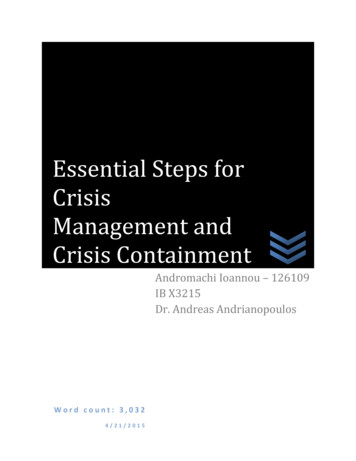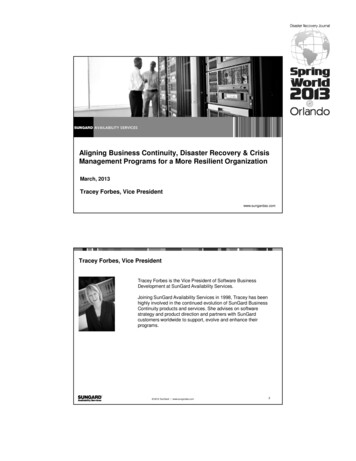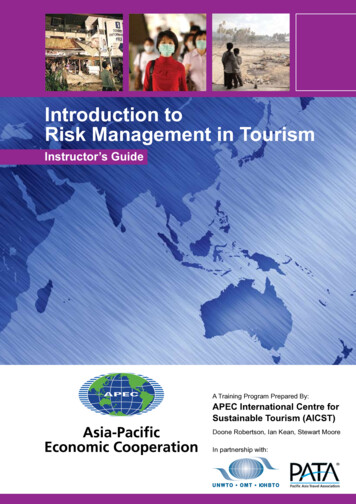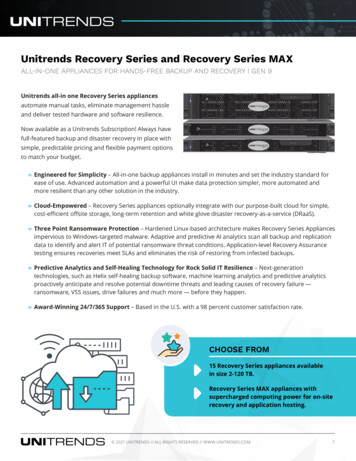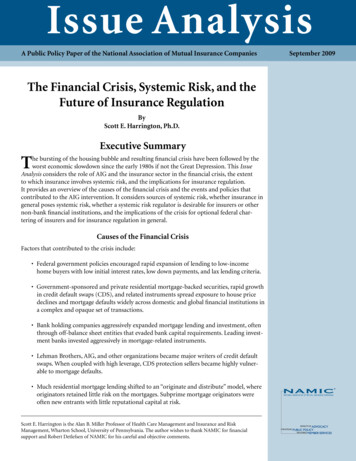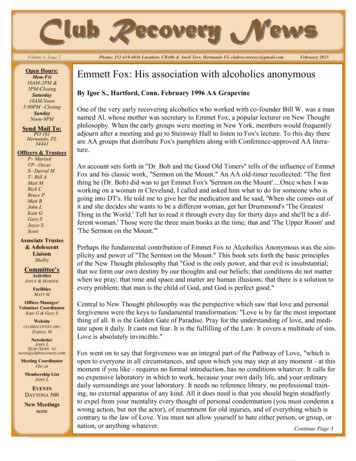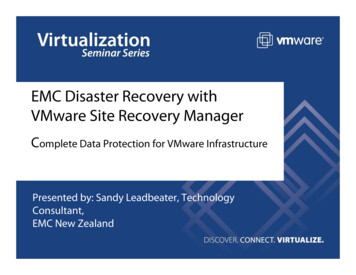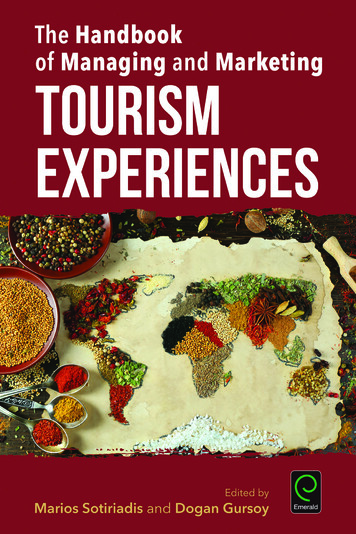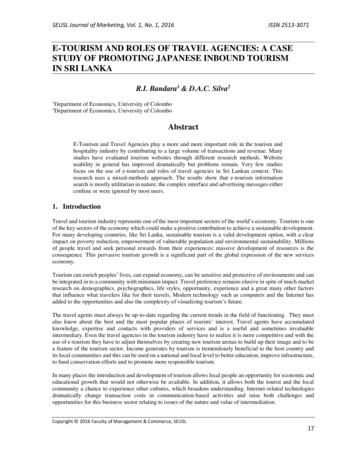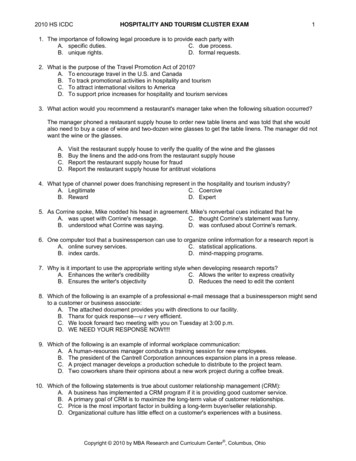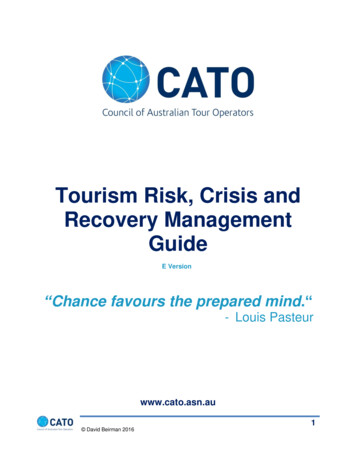
Transcription
Tourism Risk, Crisis andRecovery ManagementGuideE Version“Chance favours the prepared mind.“- Louis Pasteurwww.cato.asn.au1 David Beirman 2016
CONTENTSP3P4Part 1Defining a Tourism Crisis for WholesalersPP4-12Part 2Focus on Risk Management and SecurityPP13-19Part 3Effective Tourism Crisis ManagementPP20-22Part 4Crisis Management Template for Wholesale Tour OperatorsPP23-25Part 5Ten Point Post Crisis Business Market Recovery GuidePP26-29Part 6Tourism Recovery from Security Related Issueswith a Focus on Media RelationsPP 30-31Part 7Highlighting Social MediaPP 32-33Part 8Resources and References for Risk, Crisis and Recovery in TourismPP 34-36Appendix 1Ranking the Severity of Tourism related CrisesPAppendix 2Quick Risk Management Template for CATO members37Introduction to the CATO GuidePrepared for the Council of Australian Tour Operators by : Dr David Beirman 2016– Management Discipline Group Tourism, UTS Business SchoolUniversity of Technology-Sydney with material contributed by Bert Van Walbeek and Ken ScottISBN 978-0-9945587-1-8For: Council of Australian Tour Operators2 David Beirman 2016
Introduction to the CATO GuideCATO members whether wholesalers or national tourist offices, are often in the front line of tourismcrisis events. Almost half the tourists who book international trips from Australia will use the servicesof wholesalers for at least part of their travel itinerary. All tourists who travel internationally place adegree of reliance on destination management organisations through their offices or their websitesalong with wholesalers and travel agents to let them know about the risks which may apply tovisiting their chosen destination. In those few cases where DMO’s have no local or on-linepresence, wholesale tour operators, travel agents or DFAT’s Smartraveller website take on anincreasingly important role as the key source of information about safety in destinations.Within the travel industry, specialist risk management companies such as SOS International andIntelligent Travel have established services to travel agencies, wholesalers, cruised operators,hoteliers and corporations which focus on monitoring and travel risk information to their clients onvirtually every destination in the world. Many wholesalers and retail travel agents work closely withsuch organisations. In Australia, The Department of Foreign Affairs and Trade through the sitewww.smartraveller.gov.au keeps a close watch on safety and risk as it applies to all destinationswhich Australians visits. CATO was among the founder travel industry organisations whichestablished an ongoing relationship with DFAT in 2003 through the Consular Consultative Group.The travel industry is one of the world’s fastest growing industries. In 2015 the number of peopletravelling internationally around the world approached 1.2 billion. Of those just over 100 million werefrom China. Closer to home, according to the Australian Bureau of Statistics, out of a total of 24million Australians, there were just over 9 million resident departures in 2015. Taking into accountthose who undertook more than one trip we can deduce that by 2015 one in three Australians weretravelling internationally, one of the highest proportions of international travel participation in theworld.The overwhelming majority of those international travellers enjoy a trouble free trip and contribute tothe testimonials of satisfied customers which often feature in wholesalers’ brochures and web sitesor online sites such as Trip Advisor. However, one quality which characterises CATO members isthat all are committed to exercising a duty of care to their clients. This includes advising their clientsof potential risk and being available to help out when things go wrong.In a world of instant international communications through social media, the internet, 24/7/365 newsmedia it doesn’t take more than a few seconds for bad news to spread. Whether tourists areaffected by external threats such terrorism, political instability, epidemics, natural disasters, buildingcollapses, crime wave or internal problems such as service stuff ups, payments going astray, hotelbookings being dishonoured, delayed land, air or sea transport, lost luggage or poor meals itbecomes the responsibility of the tour operator to address the problem for their clients and to do soquickly. At stake is the most precious asset of any business, your reputation. Unfair as it may be,your daily triumphs of providing your clients with great service and product are expected – that’swhy they pay to travel with you. Regrettably it’s failures which tend to be noticed and publicised.This guide does not enable you to prevent natural disasters or prevent security threats to yourclients. What we at CATO hope it will do, is to give you some guidance on how to most effectivelyprepare your business and your staff to be conscious of risk and to sensitively communicate this toyour clients. It will also hopefully help you manage those situations when your clients really needyour assistance during a difficult situation whether that arises from external or internal causes.3 David Beirman 2016
Part 1. The Broad Context of Crisis ManagementDefining a Tourism Crisis From a Wholesaler’s Perspective:A crisis is an event or set of circumstances whichcan severely compromise or damage themarketability and reputation of a tourism business,it’s brand or an entire tourism destination region.There are two broad categories of tourism related crises which impact on tour operators:Category 1:Crisis events which are beyond the control of management:These include natural disasters, acts of war or terrorism, political upheavals, crimewaves, epidemics and sudden global economic downturns.Category 2:Crisis events which result from a failure of management action, process orlack of contingency measures taken to deal with predictable risks.These include a business collapse due to management failure, inappropriatestrategicmanagement, financial fraud, loss of data, destruction of place of businessdue to fireor flood without adequate backup procedures or insurance cover, massiveturnover orloss of management and staff. It can also include service or equipmentfailures whichcompromise the reputation of the business.Crisis and risk management is an integral part of overall tourism and hospitalitymanagement.The Critical Role of Wholesalers as Risk Managers.One of the key marketing propositions of wholesale tour operators is that wholesalers are deemedto be and market themselves as experts in the destinations they service. In addition to being expertsthey also deemed to be the safest way for the traveller to experience that destination. Wholesalershave a twin role with regard to risk as professional tour operators and a protector of their clientswhilst on tour. Your business reputation is largely contingent on your ability to shield your client fromdanger in to some extent from their own naivety. Remember, that one of the main reasons clientschoose to travel with you, rather than travel independently because irrespective of whether they area passive sightseer or an active adventurer they rely on you to shield them from risk.4 David Beirman 2016
Part 2. Risk Management and SecurityDefining Risk:Risk is essentially the likelihood or probability of negative events andsubsequent loss to a tourism business or destination arising from a negativeevent. Sometimes this can be measured statistically. Risk also factors in theconsequence of a given risk occurring,The risk of your home being robbed can be measured in accordance withcrime statistics built up over a particular period applying to a specific area.Risk assessments conducted by insurance companies are usually based onthe mathematical probability/ likelihood of a specific event occurring in aspecific location. The frequency and the consequence or cost of that eventwill be closely aligned with the premium charged,Cunliffe (2006) defines risk as follows:Risk most commonly refers to the prospect of loss.This loss is usually some form of unwanted outcome orundesirable consequence from a specific action orconsequence.The Risk Management Process(Cunliffe, Gurtner and Morgan 2006)Wholesale tour operators face a wide variety of risks. Some risks to tourism destinations and travelbusinesses arise from events and circumstances beyond the control of management and manyarise from management failures.It is an increasingly common practice for businesses to develop a risk and security audit in order tounderstand the potential risks the business may be exposed to and to develop contingencymeasures to deal with the risk event when they occur.The auditing approach also gives management the option to source insurance to cover the businessfrom risk and to take protective measures and implement alternative or backup procedures should anegative event occur.Functions of Risk ManagementIdentifyIdentify risks before they become realities.AnalyseTransform risk into decision-making information by evaluating theprobabilities, time-frames and potential impacts of each risk and thenclassifying and prioritising them.5 David Beirman 2016
PlanUse the decision making information to formulate plans and contingencyaction plans for mitigating the potential impact of each risk.TrackMonitor the effectiveness of those plans by reviewing risk data.ControlCorrect deviations from the risk mitigation plans.TreatThis could either involve transfer of risk through insurance cover orimplementing operational measures to manage negative events when theyoccur.CommunicateProvide internal and external information and feedback loops to monitorchanges in the risk environment. Communication to staff and stakeholder isvital.There is a wide a range of risks to a business related to staffing. Vetting new staff and allowing forsuccession and substitution in the event as resignation or retirement, or absence (leave/ illness)are part of the internal risk management process. While we all want to trust our staff. We need to beaware of the possibility that criminal actions undertaken by staff or errors in customer service couldresult in loss of business.An effective risk audit will take into account the effect of the risk, likelihood of occurrence and theremedial actions to be taken. In the following table are common risks which can impact on tourismdestinations and businesses.The core skill of effective risk management is the identification and prioritisation of those risks whichimpact on each specific business and destination. Too much professional time and money can bewasted on preparing for risk which will not really happen to you. Conversely, it is well worth takingthe effort to think outside the square of obvious risks.In April 2010 the eruption of the Eyjafajallajokull Volcano in Iceland resulted in a plume of volcanicash which was expelled by the volcano. The ash clouds grounded airlines and closed air space overmuch of Northern Europe. This event caught most tourism businesses completely off guard with thesole exception of airlines (which had a contingency plan developed by the ICAO (International CivilAviation Organisation).As a result, hotels had no contingency plan for dealing with excess guests or mass cancellations,land transport had problems coping with extra demand and insurance companies had conflictingapproaches to assisting stranded passengers.Having identified the most likely risks, an audit should include the measures which will be taken todeal with the event and business should ensure that whenever possible they have insurancecoverage which will financially protect the business should that risk eventuate.6 David Beirman 2016
Key Risks to Tourism and Tourism Enterprises: All Apply to wholesalersThe above risks are far from a comprehensive outline of the risks which can impact on tourismdestinations and businesses but they indicate a representative range of risks which apply to thetourism industry.THE SIGNIFICANCE OF INSURANCE COVERAGE IN RISK MANAGEMENTInsurance companies provide coverage and charge premiums based on the statistical calculation ofrisk as it applies to a wide range of specific circumstances. One would imagine that the premiumwhich may apply to avalanche damage coverage for a hotel in the Australian outback would be asminimal the risk of such an event occurring. However, the same coverage for a ski resort in theSwiss Alps would be far higher as the likelihood of this risk is considerable.Wholesale tour operators should take special care in ensuring they are financially covered for lossand damage which could arise from the most likely risks to them. In doing so a risk audit shouldfactor in the likely cost involved in the destruction to premises by fire, loss of data and claims whichmay apply to injuries at an event or a litigious client who had an unhappy holiday and wants toblame the travel provider. The minimum insurance cover for a wholesaler should includepublic liability and professional liability cover. Talk to your insurance provider about therange of coverage relevant to your business and the destinations you service. At the back ofyour mind you need to understand that you are legally deemed to exercise a duty of carewherever your clients travel to as your clients. Wholesalers working with third party landoperators should also ensure that they are covered by appropriate insurance in the countries ordestinations in which they operate.As a general rule, it is usually better to be over covered than purchase a policy which may not reallycover the real cost of loss. This is especially true in the case of property damage in an environmentin which property values and construction are subject to volatile price movements (usually upward).7 David Beirman 2016
For instance, in its Smartraveller web site (www.smartraveller.gov.au ) the Australian government’sDepartment of Foreign Affairs and Trade urges Australians travelling internationally to purchas
PP 23-25 Part 5 Ten Point Post Crisis Business Market Recovery Guide PP 26-29 Part 6 Tourism Recovery from Security Related Issues . The travel industry is one of the world’s fastest growing industries. In 2015 the number of people travelling internationally around the world approached 1.2 billion. Of those just over 100 million were from China. Closer to home, according to the Australian .
